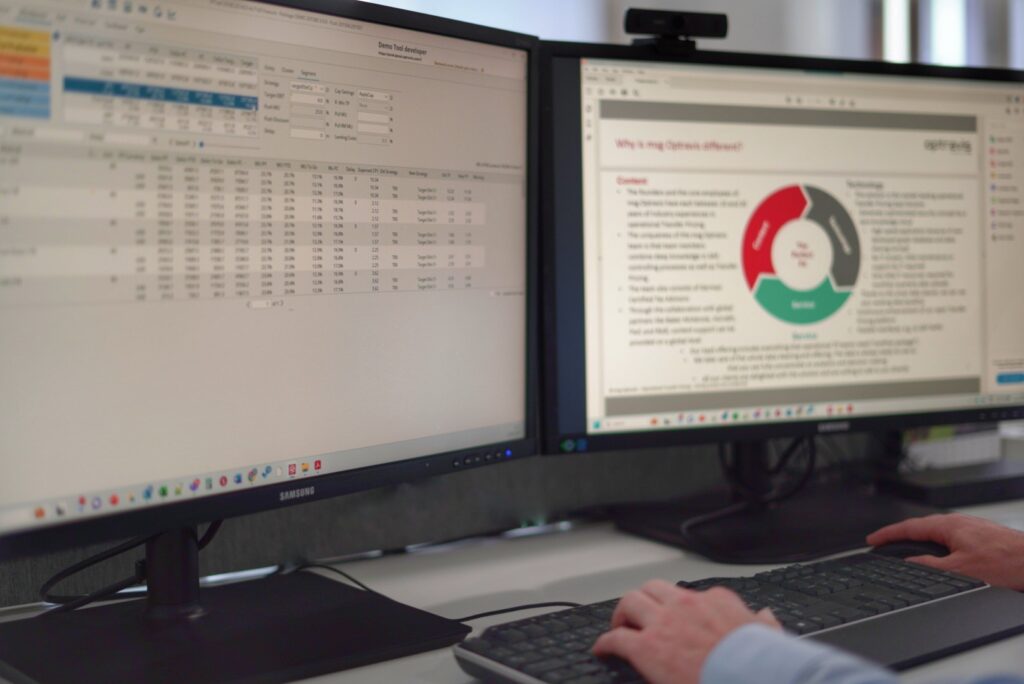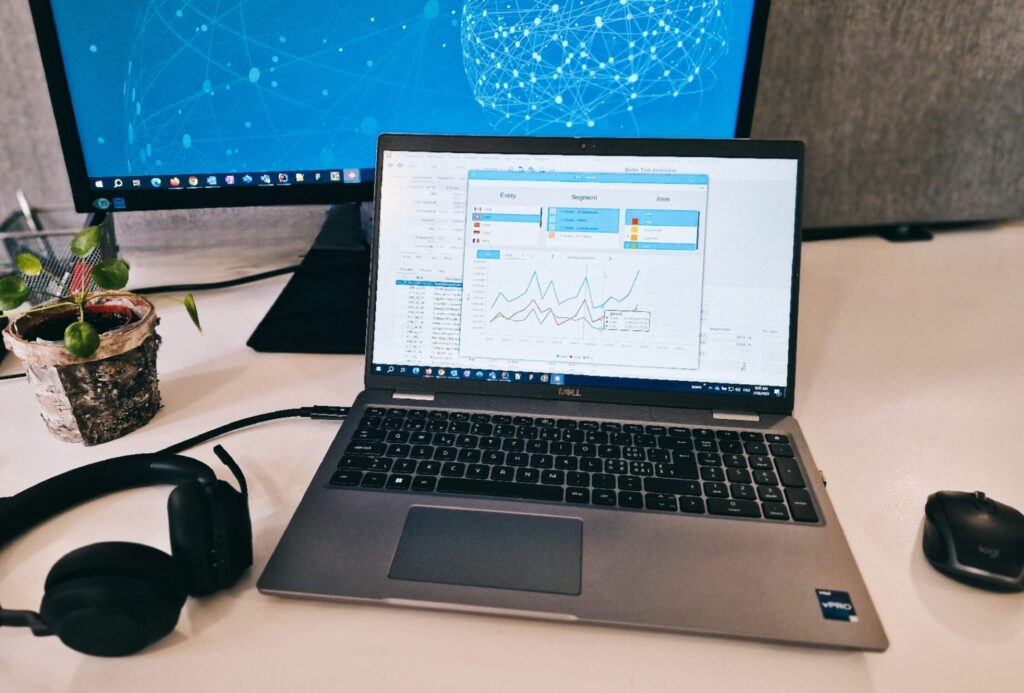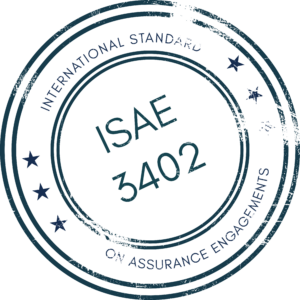Which problems do we solve with our TP Management Tool?

Thanks to our powerful in-house data cleaner and TP-specific data modeller, we can consume data from SAP R3, SAP S/4 HANA and non-SAP systems without any additional data preparation on your side. There is no need to waste time collecting, cleaning, structuring and validating data.
Finally, this solution solves the practical problem of not having to bother colleagues, access „old“ systems or extract archived data to prove to tax authorities how transfer prices were calculated and why they are at arm’s length, years later during tax audits.

Get started with a Proof of Concept project and test our TP Automation software with your data.
What you experience: Quality
Evaluate the quality and reliability of the Optravis services and experience.
In addition to using the TP Management Tool in the project environment, the proof of concept allows you to experience the Optravis services.
What you experience: Hands-on
A proof of concept is more elaborate than a standard software demo or sales presentation because it familiarizes you with the complete range of the solution’s capabilities and provides hands-on experience for OTP managers, controllers, tax and IT personnel.
The proof of concept will support the project team with its ability to perform real-time validations, analytics and simulations.
What you earn: Business case
Your benefits
Significant recurring savings - our transfer pricing software pays for itself
- We actually deliver in months, whereas other alternatives can take years and millions of dollars.
- We put you in touch with our reference customers.
- Our solution is a mature standard software that is 100% customised to your needs.
- Requires minimal IT resources. Works with SAP R/3, S/4 HANA and other ERPs.
- Ready-to-use data without manual efforts.
- Developed and improved over 15 years.
- Security and reliability are essential to us: We are ISAE 3402 certified, one of the highest standards for data security and process quality.

Compliance
Global net margin monitoring, automated transfer price calculation, automated transfer price adjustment calculation.
Efficiency
Significant reduction of manual work in the price setting process, the year-end adjustment process, the preparation of transfer pricing documentation and during tax audits.
Flexibility
Supports multiple ERP systems such as SAP R/3, SAP S/4 HANA and other non-SAP ERP systems, seamlessly integrates into existing setups, handles complex operating models. Direct transfer price upload to your ERP system.
Consistency
Global process harmonization, globally consistent P&L segmentation and TP medhods, and a single source of TP related data.
Transparency
Detailed value chain at material level, dynamic automated segmentation, full audit trail.
On- and offline
Allows you to work online and offline and upload changes when you have internet access.
Latest Technology
High-performance and secure transfer pricing software with in-memory graph database and zero-knowledge data store.
SaaS concept
100% cost control, predictable project, implementation and maintenance included, no surprises or overruns.
Unlimited users
Unlimited number of users.
The Data Cleaner processes the data downloaded from the ERP system. It performs necessary harmonisation and transformation steps, such as eliminating inconsistencies that can occur when data is downloaded from different ERP systems or data sources. The formats of the input data are usually very different from customer to customer. The Data Cleaner is therefore the most customised software component. The Data Cleaner transforms the raw data extracts received from the customer into a standardised format or data model and generates compressed and encrypted data packets. The Data Cleaner component is preferably hosted by Optravis in the Microsoft Azure cloud (e.g. on European servers), but can also be hosted locally on a suitable server at the customer’s premises.
Highlights
- Integration of SAP and non-SAP data.
- You do not have to “improve” your data for us.
- We take care of all the (master) data cleansing and the elimination of data inconsistencies coming from different ERP systems.
- We know what data fields you need.
- If you think your data is not good enough for such an automation, let us do a Proof of Concept with your real data and you will see that it works.
The Flow Analyzer is a custom-built high performance Business Intelligence solution optimised for operational transfer pricing purposes. Compared to traditional relational databases (SQL) or multidimensional cubes (OLAP), the Flow Analyzer uses an own developed in-memory graph database that is exceptionally fast.
Highlights
- Integration of SAP- and non-SAP data.
- Comprehensive visualization of value flows.
- Interactive and flexible analysis of transactions in milliseconds.
- Real-time change from bird’s eye view to full transaction details at invoice and material level.
- Plant, product, customer profitability.
- Reports can be created for multiple use cases such as consolidated margins, VAT and customs analysis, etc.
Segmented reporting involves breaking down a company into its tax relevant functional segments and allocating revenues, COGS and OPEX to each segment. These segments can be fully customised in the tool to suit the client’s business model, as they are influenced by a number of individual factors such as management requirements, accounting standards and, most importantly, country-specific tax regulations. Differences between group GAAP and local GAAP can be maintained. Typical segmentation hierarchies are Company – Business unit – Function – Trading partner relationship.
Highlights
- Flexible and fully customisable P&L segmentation.
- Dynamic allocation of SG&A / OPEX costs.
- Multi-dimensional segmentation (cluster/transaction).
- Direct and indirect allocation of overheads.
- Automated overhead forecasting.
- Manual corrections possible (e.g. differences between group GAAP and local GAAP, year-end adjustments).
- Enormous transparency through automated monthly or quarterly P&L segmentation, enabling much more precise TP setting and margin steering.
The Price Setting Workbench module automatically calculates transfer prices per product and per trading partner relationship based on rules. For each defined segment, new transfer prices are generated based on pre-defined methods or requirements such as target margins, user-defined rules (external rules), user-defined parameters or thresholds (internal rules). The tool supports all transfer pricing methods (e.g. C+, resale minus, TNMM, profit split, CUP and mixed methods) and covers all commodity supplies (e.g. finished goods, raw materials, intermediate goods, etc.). Finally, the Workbench allows the calculation of all worldwide transfer prices, holistically optimised with any number of tax, TP, customs, anti-dumping, etc. rules. We can model direct and drop shipments as well as component manufacturing and project business. In addition, calculations for royalties, commissions, drop shipments or consolidated group margins can be managed.
Similar to the P&L segmentation, the Workbench includes comprehensive forecasting functionality, where forecasts are either generated automatically by the module itself, entered manually or imported by users (e.g. from budgets or existing forecasting systems).
In addition, a visualisation panel allows the creation of charts that illustrate trends for key financial data relevant to transfer pricing, such as prior years, actuals, forecasts.
Highlights
- Fully automated calculation of TP’s and real-time simulation of impact at product level.
- Fully automated consideration of all TP methods and pricing strategies such as C+, target net margins, R-, profit splits, CUP (e.g. for Brazil), customs rules, etc.
- Manual, customised or fully automated forecasting capabilities at product and/or transaction level.
- Automatic download, validation of transfer prices including audit proof upload to ERP systems such as SAP.
With a negotiation workflow documented in the tool, the Pull Negotiation Workflow module provides the necessary flexibility for cases where automatic transfer pricing is not possible, permitted or desired. Typical examples are the pricing of new products, new trade relationships, special transport types, slow movers, old stock, key raw materials, etc.
The software already suggests an initial transfer price. It is possible to simulate the P&L impact of this new price.
As the reasons for setting the price can be documented directly in the comment field, it is fully traceable, even years later in tax audits, why who set which price. There is no need to search through emails and files.
Highlights
- Integrated and fully documented negotiation workflow.
- Negotiation and case-by-case transfer pricing management in special cases such as negotiating transfer prices for new products, slow-movers, critical raw materials, strategic commodities, transfer prices in changing business models, difficult regulatory environments, etc.
- Improved alignment of operational transfer pricing needs with operational business requirements.
- Order-to-cash friendly process through automated, validated and audit-proof upload of transfer prices directly into SAP.
The price list module provides the user with a customisable transfer price list for all global materials/products sold within the group. Existing conditions in SAP can be easily compared to the price list and modified via the bi-directional SAP interface. Alternatively, a customised export function can be implemented to generate files (e.g. XML or CSV) for batch upload via standard interfaces. An approval process for releasing the new transfer prices can be activated in the tool.
This module automatically checks whether the overwriting of conditions has actually taken place in SAP.
For companies that do not want to overwrite the transfer pricing conditions directly, we have developed different implementation variants (e.g. price splitting, mark-up 1 and 2, EBIT impact simulation for the difference between controlling and tax prices, etc.), so we are convinced that we can also offer a suitable and implementable solution for you.
Highlights
- Global overview of all maintained and valid transfer prices at product and trading partner relationship level.
- Direct interface to ERP system for price maintenance and download (price validation).
- Various export templates for further processing (e.g. maintenance of purchase info records or standard price adjustments).
- Automatic creation of new and additional conditions (improves order-to-cash process).
The Tax Dashboard provides comprehensive access to all available key information at global, company, business unit and segment level for quick and efficient assessment of opportunities and risks. It allows the user to navigate directly between the Tax Dashboard and all other modules, e.g. to see the affected value flows in the Flow Analyser. Each user can create and save their own dashboard.
All information can be exported for analysis, presentation and transfer pricing documentation. The tax department can enter and maintain all interquartile ranges and target margins per segment worldwide.
Highlights
- Dashboard with all relevant key information for a fast and efficient risk assessment.
- The dashboard can be flexibly customized for controllers, tax/TP experts, CFOs etc.
- Over 50 data fields can be displayed.
- Users can jump directly from the tax dashboard to the other modules for easy deep dives.
- All information can be exported to TP documentation, presentations, Excel.
- Simulation of the tax impact of different TP strategies and target margins.
The IC Matrix report generates the intercompany transaction matrix based on the transaction data covered by the data model. Any rules can be customised to map individual transactions to transaction groups. The transaction volumes correspond to the revenues of the respective functional P&L segments. Thanks to the high granularity of our data model, the user can easily break down the IC transaction group volume into all the underlying sales/invoices. This makes it easy to respond to tax audit requests within minutes, even years later, independent of other departments and any historical ERP changes/migrations.
Highlights
- Flexible mapping of transactions to transaction groups.
- Fully reconciled with P&L segments.
- Easy drill down to all underlying individual invoices.
- This module will save you weeks of manual work.
- IC Matrix shows not only seller, buyer, transaction group, volume, currency, but also TP method, target margin and actual margin.
- The user can export the entire IC matrix to Excel.
- We can customise interfaces to pass this matrix to TP documentation tools.